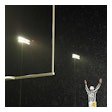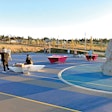![Astroturf installation at Roxana High School. [Image courtesy of YouTube]](https://img.athleticbusiness.com/files/base/abmedia/all/image/2021/09/ab.spot921_feat.png?auto=format%2Ccompress&q=70&w=400)
When one thinks of synthetic turf applications in sports, thoughts may turn to the type of grass-mimicking installation that debuted at the University of Nebraska more than 20 years ago, or perhaps all the way back to the carpet-like surface that succeeded a year's worth of failed natural grass and painted dirt experiments at Houston's Astrodome in 1966.
Dan Bond thinks of the parent whose daughter is better able to play baseball because of synthetic turf. "I had a conversation with a mother who has a child who is physically impaired," says Bond, president and CEO of the Synthetic Turf Council, a 240-member industry advocacy group founded in 2003. "She has to use a wheelchair, and she loves playing on a synthetic turf baseball field because there aren't the ridge lines between the dirt and the grass that make going around the bases and going around the field a lot more unsafe for her."
From elite athletes competing at the highest levels to kids simply seeking participation opportunities, synthetic turf serves a range of audiences with products and performance characteristics that — in many cases — natural grass simply can't match. And the industry, slowed only slightly by the COVID-19 pandemic, continues to march ahead. According to Bond, between 12,000 and 15,000 synthetic turf fields are currently in the ground across North America, with 1,200 to 1,500 fields being replaced each year. The University of Texas just updated the synthetic turf field inside Royal-Memorial Stadium, citing its use for band practice as one reason a return to natural grass just wasn't going to cut it.
The landscape is increasingly dotted with new synthetic turf installations, too. This fall, 105 of the Wisconsin Interscholastic Athletic Association's 512 member high schools will employ synthetic turf in some capacity, with some schools sharing fields. WIAA turf adopters numbered just 77 in 2017 and 38 in 2013.
Conversion case studies are everywhere, and for good reasons. The University of Northern Colorado reported in late July that converting 26-year-old Nottingham Field from natural grass to synthetic turf will save between 2.3 million and 3.2 million gallons of water each year — roughly the equivalent usage of 20 to 30 homes. Maintenance staff will be spared 22 labor hours lining and mowing the field, and $1,350 in field paint will be saved — every single time the Bears host a home game. Fertilizer treatments, rendered obsolete by the conversion, should add another $1,400 in savings annually, the school reports.
The maintenance savings multiply when you consider Bond's contention that one synthetic turf field can do the job of three natural grass fields. That utility will no doubt come in handy at Roxana (Ill.) High School, which put the finishing touches — including a three-color, 30-yard-wide shell-shaped logo inlay — on a synthetic turf football and soccer field this summer.
"The facility upgrades will enhance student safety and ensure that Roxana athletes, students and community members will enjoy first-class athletic facilities," a district release states. "Located, landlocked and operating on the same footprint since 1941, the district is not able to fully support programs because of insufficient space for practices and competition."
Meantime, turf manufacturers aren't resting on such laurels. Here's a look at recent innovations within three key components of most synthetic turf systems:
![FieldTurf installation at the University of Texas. [Images courtesy of Twitter @TexasFootball]](https://img.athleticbusiness.com/files/base/abmedia/all/image/2021/09/ab.spot921a.png?auto=format%2Ccompress&fit=max&q=70&w=400) FieldTurf installation at the University of Texas. [Images courtesy of Twitter @TexasFootball]
FieldTurf installation at the University of Texas. [Images courtesy of Twitter @TexasFootball]
Fiber technology
The advent of long-pile fibers revolutionized the synthetic turf industry as the 21st century dawned. Longer fibers looked more like natural grass and their polyethylene formulation provided a softer, more player-friendly experience compared to the abrasive nylon carpets that had dominated the industry for decades. That said, polyethylene couldn't match nylon's durability.
Now, companies are creating dual-polymer solutions to enhance the polyethylene experience while addressing its shortcomings. One manufacturer has perfected an extrusion process that wraps one polymer around another to form each fiber. A different manufacturer uses specialized molecular compatibilizers to fuse polyethylene and nylon, which ordinarily repel each other, into a single filament. The goal with these more complex manufacturing approaches is to further match the look and texture of real grass blades, while exhibiting durability and resilience not seen in the monolithic deep-pile fibers of the past.
RELATED: PRODUCT SPOTLIGHT: Stadiums and Outdoor Surfaces
Infill technology
Crumb rubber has proven quite resilient as a synthetic turf infill material — in more ways than one. Concerns over possible cancer links have so far largely been debunked, and the product — typically comprised of recycled car tires and often combined with silica sand — remains in use today in a vast majority of installations.
But here, too, manufacturers weren't satisfied to offer only the status quo solution, instead introducing a variety of infill alternatives to the marketplace in recent years. These include natural materials derived from olive pits, coconut and walnut shells, cork and even wood, which is sustainably raised, harvested and refined through a multistep process into a safe and stable particle size and shape. In some cases, a combination of materials may be used within the same system — cork and a thatch layer of coconut fiber, for example. Key performance considerations include heat and abrasion mitigation, moisture retention, shock attenuation, energy restitution, vertical deformation, foot traction and ball reaction, and the material's migration resistance (its susceptibility to fly out under foot or float away on heavy rain runoff).
It should be noted that these alternatives require that an underlayment be included in the overall turf system, a fact that's even true of some synthetic infills, such as those made from extruded thermoplastic elastomers or recycled athletic shoes.
It should be noted that these alternatives require that an underlayment be included in the overall turf system, a fact that's even true of some synthetic infills, such as those made from extruded thermoplastic elastomers or recycled athletic shoes.
While debate over whether crumb rubber harbored potential carcinogens raged in recent years, there has been no denying that the product's dense, dark characteristics exacerbated another, legitimate safety hazard — heat gain. Many infill alternatives address surface temperatures rising well into triple digits with material that's lighter in weight and color, and in some cases treated with a technologically advanced coating that actively enhances a field's evaporative cooling process.
Shock pad technology
The least visible part of certain synthetic turf systems has seen some of the greatest advancements.
Shock pads are often specified to complement and enhance the resilience afforded by a system's fibers and infill, but products on the market today also claim to reduce or eliminate the need for traditionally expensive and labor-intensive stone, concrete and asphalt foundations — while allowing for precisely engineered drainage — using structurally stable interlocking panels.
A pad should balance shock absorption and consistent firmness under foot, in a fast-draining, long-lasting solution. By molding polypropylene in pattern-textured panels, manufacturers dictate how the pad both responds to play on the surface and channels drainage water beneath it. Moreover, how the panels interlock is carefully engineered to mitigate shadowing through the turf while accommodating thermal expansion.
Even adhesives that hold the various layers of a system together have improved to the point installation can take place in conditions ranging from subfreezing temperatures to desert heat, while minimizing volatile organic compounds, odor and overspray when using airless spray applicators.
RELATED: Find more solutions for your facility in the Buyers Guide
According to the Synthetic Turf Council's 2020 Market Report, approximately 265 million square feet of turf and 436 million pounds of infill have been spread across North America — in the form of individual baseball diamonds, football fields and sprawling soccer complexes, among other sports applications. The total value of installed synthetic turf systems is estimated to be $2.7 billion.
Those pondering their own individual investment continue to be guided by an industry that is ever-evolving, always with an eye toward ensuring playability that mirrors a pristinely manicured natural surface, as well as the physical safety of its end users.
"The designer/manufacturer can specify the components for the system," Bond says. "There's a lot more flexibility and there are a lot more options for end users when it comes to what the field will do — the types of sports that they want to play on it and the overall player safety aspects, as well."
This article originally appeared in the September 2021 issue of Athletic Business with the title "Synthetic Turf Systems Continue to Advance — at Every Level" Athletic Business is a free magazine for professionals in the athletic, fitness and recreation industry. Click here to subscribe.

































